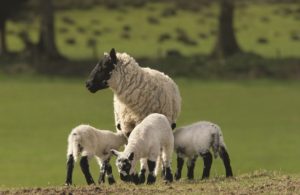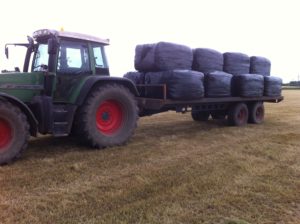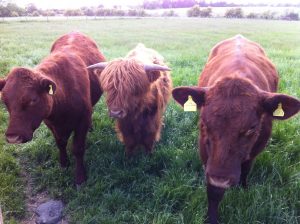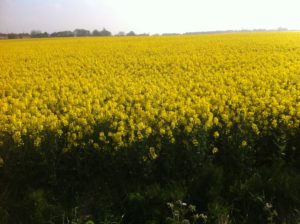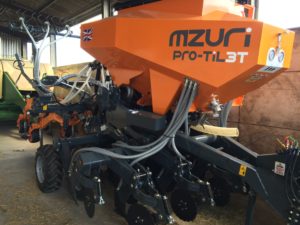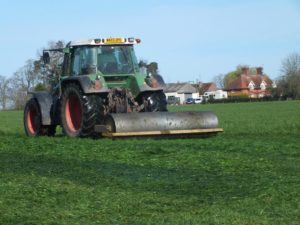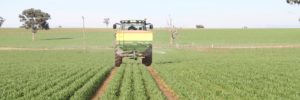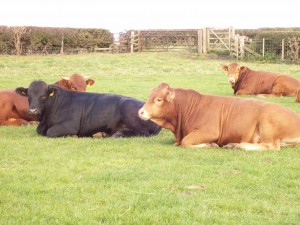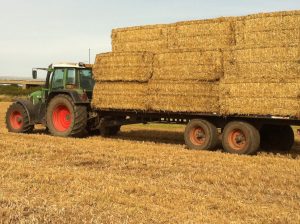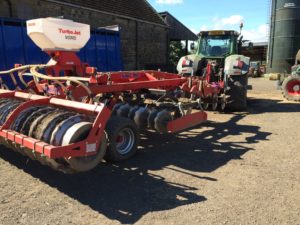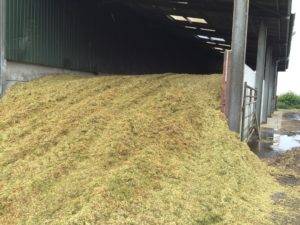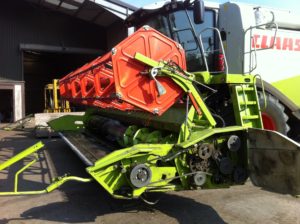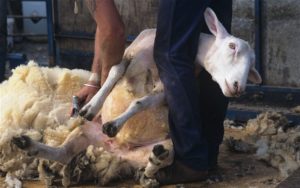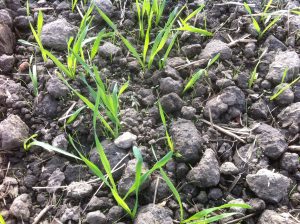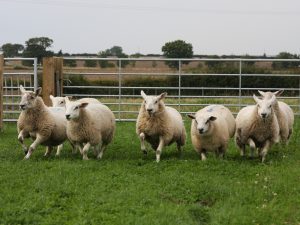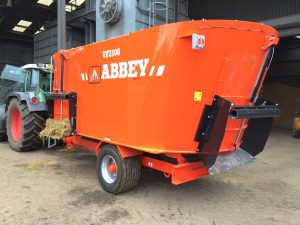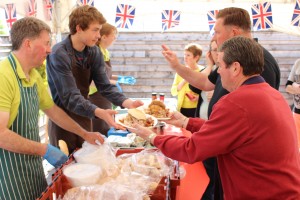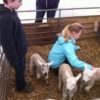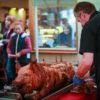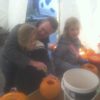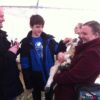Latest News
Down on the Farm May 2019
Lambing is well out of the way now -it was a pretty easy one this year with the weather just falling right for us. There was fairly decent grass growth early on this year due to the warm spring so we were able to turn ewes and lambs out pretty much straight away onto fresh pasture. The lambs are growing well – fresh grass is always the best thing for good milk production in the ewes. We’ll be able to get some up to the paddock at the farm shop shortly as the grass there gets going. Keep an eye out as well for the new Pot Bellied pigs and Boer goats at the farm shop – they all seem to settling in well.
Next big job is first crop silage – this has come a bit earlier this year, partly due to the warm weather and also from some newly planted “seeds” fields which are ahead of the rest. Hopefully this will be done by the middle of May. This will be baled and wrapped ready for cattle feed for next winter. Properly wrapped and sealed, the grass ferments slightly and forms its own preservative acids. This will get chopped and mixed with our own cereals when the cattle come in next winter as the grass stops growing. We have also done some whole crop silage on some other arable fields planted very early last Autumn and now going into beans. This is part of the ongoing crop rotation programmes we are trying to work on to increase soil fertility etc so that we need to use less fertilizers and sprays.
The start of May also sees us starting to turn cattle out again after being housed for the Winter. This generally provides us with our annual fence checking opportunity as the cattle take advantage of the opportunity to stretch their legs and go for a gallop, occasionally realising too late there is actually a fence around the field. Wire fence versus 1 tonne of beef on the hoof generally has only one result – yup, repair time. Then it will be a big mucking out session to get the sheds emptied and the manure stacked ready to go back onto the fields as they become available. Yet more organic material and fertility going into the soil for the arable land.
The arable crops are generally looking well – again benefitting from the warm winter. We just need to keep on top of any weed and pest issues as warm weather suits them as well. We have a little more oilseed rape than usual this year so things have been looking a bit yellow around the place over the last few weeks. This is a great crop as part of the rotation with wheat and barley, as well as producing a useful seed in it’s own right. Ours goes for “industrial” use rather than for human consumption, which could mean anything from mineral oils to cosmetics.
Down on the Farm – August 2018
You can’t have missed the fact that it’s been a bit dry recently – this has brought us mixed blessings at the farm. Our first cut of silage was a little light but was great quality. The heat meant that we were able to cut and wilt the grass quickly and then get it bales pretty much the next day. This helps to conserve as much of the nutrients as possible which gives good fermentation and so improves feeding quality for the winter. Unfortunately, the lack of rain has meant that grass re-growth has been poor so we have only been able to make a very small second cut. Hopefully what we have made will be sufficient to see the cattle through the winter period. From what we have heard and seen in the media, we are better off than many folk who have already had to start feeding stock with feed destined for this winter. We have been giving some of the larger cattle a little extra cereal ration just to make sure they keep condition – normally they would be fine with grass only at this time of year. The small amounts of rain we have had has at least given us a bit of growth in the sheep pasture fields so we haven’ had to suppletory feed any sheep yet.
The cereal crops have been doing OK, although yields are probably down a little due to the lack of moisture earlier in the growing period. There has obviously been no problem finding dry days to get the crop cut through – the barley came in early and we are virtually finished the oilseed rape at the time of writing. The barley will all be kept for animal feed this year – it gas been treated with an inoculant which allows it to be stored safely without going mouldy. This will then be rolled and mixed with silage and a vitamin/mineral balancer during the winter. The straw yield is poor this year – basically the stalks just didn’t grow to their normal length due to the dry conditions. We have been baling every last bit, including all the rape straw to make sure we have enough bedding for the pigs and cattle.
The wheat crop is looking promising – I think the weeds have also had a tough time in the dry and the crop is very clean so hopefully yields will be good. Again, the crop is short so we expect the number of bales we get to be lower than normal. Looks like the straw will be a high price this season then!
We’ll soon start sowing next years crops, beginning with winter rape. Hopefully we will get a little bit of rain to soften up the soil before we start discing and drilling with the latest addition to the machinery fleet. This cultivates the ground and incorporates and stubble, then sows the rape seed before pressing the surface of the soil again to retain moisture and provide a good seedbed for germination. By doing three processes at once it helps speed things up and also reduces compaction of the ground which helps crop growth. Its also cheaper as we don’t use as much fuel and labour. It does take a fairly hefty tractor to pull it though.
The pigs are doing well – they are perfectly happy with the hot weather as long as they have access to plenty of water and shade. We have been letting the muck areas stay a bit wetter than normal as well to give them more chance to roll in the muck and cool off. Otherwise they seem very happy just to snooze the day away, with the occasional trip to the feed trough to top up!
Down on the Farm – May & June
Down on the Farm – May & June 2018
After what seemed like an endless winter and poor start to spring, the hot weather at the end of April and now into May has got everything moving again. Suddenly it seems as if al the crops have decided it’s safe to get into a growth spurt, so that’s where things have been busy recently.
Our silage fields have received their latest application of nitrogen fertilizer to make sure there are enough nutrients available to take advantage of the good growing conditions. At some point in the next few weeks they will be rolled with a heavy steel roller to press any stones down into the soil so that they don’t get picked up by the mower. The natural heave of the ground during the winter frosts etc causes rocks to move gradually up through the soil until they poke out the top. As we mow very close to the ground to maximise yield, any rocks sticking up can cause some serious damage to machinery – best avoided if you don’t want big bills for replacing blades. Rolling also helps flatten the ground generally so that when we mow close to the surface we don’t scalp any high spots and end up with soil contamination in the silage – the bacteria in the soil can cause spoilage.
Although we do spread a fair bit of farmyard manure from the cattle on the fields, the arable crops have also had their allocation of fertilizer – their requirements are a bit more complex than the grass so they have a blended fertilizer with various nutrients to keep things balanced. This makes sure we have a healthy crop which is able to withstand diseases and pests better and also grows fast enough to keep any weeds back. Timing of the application is important – it needs to be available when the growth spurts are happening. The temperature and moisture of the soil also plays a part – if things are too dry the nutrients from the fertilizer just don’t get drawn into the soil. We also have some more spraying to complete on the winter crops to control weeds and pests. If we don’t catch these at the right time they can have a big effect on eventual yields at harvest. The oilseed rape crop has come into flower well – the distinctive yellow flowers really stand out. So far it looks like the oilseed has survived the winter well and will set plenty of seed. The tiny black seeds it produces will go away for crushing to extract the oil. This goes into many different things – cosmetics for example. Some crops are grown especially for oil for cooking – these are specialised varieties which are harder to grow. The team at Yellow Fields near Morpeth grow these to produce the rapeseed oil we stock in the farm shop.
A large number of the cattle have been turned out again now the grass has started to grow more quickly. It’s been a later start to the grazing season than normal as it’s only recently that the fields have been in the right conditions. The normal rodeo ensues as soon as they get out of the sheds – they seem determined to check out every corner of the pasture at a full gallop so it’s best to stand back and let them get on with it. The rest of the cattle will all be out in the next two weeks and then the empty sheds will then be mucked out and the manure stacked to compost down a bit until we spread it after harvest.
We will also need to start thinking about getting sheep sheared – generally this starts in June, but if the weather remains hot then we might need to bring this forward. The lambs are growing well now the grass has started to grow – they are already nibbling away at the fresh stuff although they are still feeding from the ewes. Pigs being pigs, they generally cause us little problem as long as they get well fed and have plenty of straw to rummage and sleep in. When it gets hot they also take great pleasure in getting as dirty and wet as possible before coming back into the nice fresh clean straw we have just put into their sleeping areas – and they don’t even wipe their feet.
Down On the Farm Feb & March 2018
The winter so far has been pretty good to us compared to some other places further south – we seem to have escaped the snow to a great extent, at least so far. We’re not great fans of the white stuff – it’s pretty to look at but it does make pretty much every job on the farm harder to do. It’s easy to forget how much water is actually in the stuff as well – apparently a 4-5” snowfall of the wet type we generally get in the UK is the same as dumping an inch of rain on the land. In other countries they need 10” of their nice powdery snow to have the same effect. How do those lads in the Alps cope when it melts? I recall visiting some friends in Northern Canada as a kid – he farmed maize and basically shup up shop for the entire winter and took another job driving trucks on the ice roads up there until the ground went green again.
Our crops have been pretty dormant for the last few months but have started to show signs of a bit of movement in the last week or so. Nothing is in need of fertilizer yet so we will wait a bit longer before applying anything – it’s always a balance between growth stage of the plants and the right ground temperature and moisture content. If it goes on too early and the ground is too cold, the active ingredients just dissipate without the plants being ready to take them up. Not very efficient and we end up having to apply extra later to make up for it. We also have to be very aware of how soft the land is to avoid causing damage through compaction. Although we do use tramlines in the crops we always try to minimise damage as much as possible. Tramlines are simply rows in the crop where we don’t sow any seed leaving the same obvious track that is used every time we need to do work with the crop. This way we keep compaction to a very small area of the field and we can then run a subsoiling plough through these areas after harvest to break the ground up again.
We have spent some time getting some of the cattle sheds mucked out and the manure stacked on hard pads ready for applying later in the year. The ground has been too wet to actually get it spread on the fields – we need a few good days of heavy frost to allow the big trailers to travel without sinking in. The manure composts down better when it is stacked – the natural heat build up in a muck heap is surprisingly high and helps break down the organic matter as well as killing weed seeds which might get carried onto the fields later. A decent stack should get crier and more crumby as time goes on,
All the cattle are still indoors so it’s very much the normal feeding and bedding routine for Wade and Maurice, our farm staff. In between they try to do any fencing, mend gates, service machinery etc while things are quiet. The sheds are reasonable full just now although we have been regularly selling finished cattle since the start of the year. Victoria’s Dad is away visiting family in New Zealand so we will wait until he gets back before any more store cattle are bought to fill things up again. Store cattle by the way are young small ones that we buy in from local farms which we then graze and feed over the subsequent year or more until they are the right weight and condition for slaughter . Don’t worry though – we still have plenty for the farm shop – in fact, only a small percentage of our beef cattle are selected for the shop, the rest go to other butchers and general food trade. That means that we can choose the very best for ourselves – lighter animals with just the right amount of condition so that we can hang them well for taste and texture.
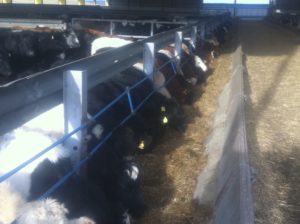
The ewes are in decent shape and are getting a bit of extra feed as pregnancy progresses. It’s a pretty basic mix of rolled barley with some vitamins and minerals which we make ourselves. If the grass gets particularly short then we will also provide silage to make sure they have enough forage. Being ruminants, it’s important to keep sheep and cattle with full stomachs. The mixed diet makes sure they have the enough energy to keep the lambs growing well but without the ewe getting over fat. Often, ewes in too good a condition are more prone to lambing problems so we try to avoid it. The opposite is also true – too thin and the lambs are not as strong plus the ewes milk quality and output is reduced.
The pigs are probably the least bothersome enterprise we have on the farm – as long as they are well fed and watered and have plenty of straw to bed down in they are happy. Generally the only problem we get is with frozen pipes and drinkers – fortunately this year we haven’t had too much frost to cause problems inside the buildings. It’s never much fun trying to thaw yards of piping while the pigs chew your wellies as they wait for the water to come through. It’s even more annoying when the tractor driver pops in from his nice heated cab to tell you how wonderful it has to have the heavy frost and now he can get on spreading his muck (see earlier paragraph)
Down on the Farm This August
We are well into harvest now, although it has but a bit of a stop-start affair so far. Generally, we cut winter barley first, followed by oilseed rape and then winter wheat. Not this year though – having sprayed off the oilseed rape to get it to ripen and dry a bit earlier the weather turned and we ended up behind with the barley. So in spite of trying to forward plan we still ended up with both crops needing to be cut at the same time. Fortunately, we managed to get some long days in and got through without too much loss. Rape seed is very fine and when it’s ripe, any heavy rain shakes and splits the pods and the seeds drop out onto the ground. Not only do you lose some of the yield but it then self seeds amongst the following years crop – luckily, we got most of it safely in before the heaviest rain. We haven’t had to do much drying this year so far – so the yard has been a bit quitter than normal at this time of year – the dryer fans do cause a racket to be fair.
We are now at the stage of having to both harvest crop and also start preparing land for planting next years crop. It’s a lot faster than it used to be with some of the big machinery we now have. The first thing we need to do is get the straw off the fields – the big square baler we have can cover the ground pretty fast and with the large high density bales its also faster to lift and load them onto the trailers and get them stacked back at the yard. Handling the thousands of little bales we used to do when I was a kid is fortunately now long gone apart from some hay which is baled for the horses. You always knew when you were stacking small bales as your hands were raw and the knees got worn out of your jeans as you hefted them up onto the trailer. Now we just sit in the loader and let the hydraulics do all the work
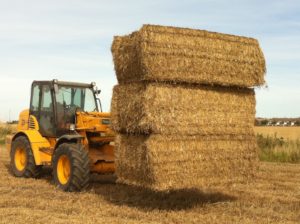
To speed things up we also do as much direct cultivation with discs and tines and only plough where we need to. Ploughing is great for incorporating long stubbles or to help control weeds etc but it is a relatively slow process and the ploughed land still needs to be cultivated again to prepare the seedbed. Big heavy multirow discs with cultivator tines and rollers can also direct drill rapeseed into the stubble from the previous crop as long as ground conditions are right. The machine in the picture allows us to do that where its sensible.
The livestock side is fairly quiet at this time of year apart from keeping on top of lamb and cattle growth so we select them at the optimum weight and condition. The lambs are rotated around onto fresh grass where its possible so that we can maximise growth rates with high quality summer grass that’s available. We’ve also been preparing feed for next winter – the grass silage was all done earlier but we have cut some fields of wheat before they are fully ripe – this is called “whole cropping”. It’s not something we do every year but Basically, we cut and chop the entire head and stem and then its put into a silage pit and sealed so that it ferments. The acid produced preserves the crop until we need to use it for winter feed. It gives us a great high protein feed to help balance out the grass silage for the cattle. An added benefit is that it allows us to get ahead with autumn sowing as the fields are available earlier than they would be if we let the crop ripen and harvested as normal
Down on the Farm July & August 2017
Down on the Farm
July/August 2017
By the time you read this all of the silage will be cut and baled and stacked ready for next winters feed. The early cut was a bit low on volume due to the dry start to the season but the main later cut has been good with decent volumes and nutrient levels. We had decent weather during cutting as well which means we can get the crop cut, spread, wilted, re-rowed and baled within two to three days. This helps preserve the nutrient levels and therefore the feed quality for the coming winter. If you have seen any of the purple wrapped bales around anywhere – they’re part of a charity fundraiser for a local agricultural supplier (Carrs Billington) – certainly eye-catching. I’m afraid ours are just boring green as we had quite a supply of wrap left from last year to use up. The machinery played ball most of the time as well with only a few minor stoppages for mechanical stuff. Most of the newer kit has that many sensors and alarms that we are generally warned well in advance if something is starting to go wrong so that’s usually a help. However, all it takes is one big rock or branch to make a mess of your day as it lunches it way through the mechanics. Obviously, this never happens to us though – only other people!!
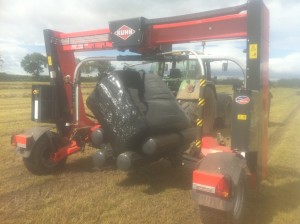
Things will start getting busier from mid July on as we start to move into harvest – we should be onto the early barley during the last week of the month if the weather holds and continue on all through August. The crops are generally looking well although some more rain earlier in the season might have given us higher yields. However, the pest and disease levels have been better than normal for us this year so that has helped. The combine will have had a good check over before heading out – hopefully we will spot anything amiss before we get a breakdown in the field. The first few times around the field are always a bit anxious and every funny noise or vibration gets the drivers imagination going. The first unload on the move is always a laugh as well – it always takes me a couple of loads to get the speed matched properly to the combine so you avoid grain spilling over the edge of the trailer.
After the barley we will get onto the oilseed rape – we have a lower acreage of this than normal so that shouldn’t take too long. Depending on the weather we hope to get away with the minimum of crop drying this year – we need to get the moisture levels down below a critical level if we want to store grain for feeding over the winter. Obviously the more this is done by the nice free sunshine, the less we have to do through the expensive drier.
Once we get into the wheat then it gets busier as we will also be starting to prepare ground for the next crop. We’ll take this opportunity to spread some of the manure stacks on the stubble fields as well – extra fertility and organic matter into the spoil produced by the housed cattle and pigs during the winter. By doing this and using grass and oilseed rape as break crops in the rotation we aim to keep the soil in good health.
The cattle become less time consuming during the summer as they are all out at grass. Obviously, they all have to be checked a couple of times a day along with water troughs, any feeders etc but generally they just get their heads down and get on with the business of grazing and putting on weight. The pigs like the warmer weather as well – we let the muck passages get a bit wetter than normal so that they can roll about a bit and cool off if they want. Their shed is well sited though and the boarding on the sides is designed to direct the air through the building so it never really gets too hot.
Down on the Farm – May 2017
With lambing well and truly out the way, things have settled down again to a more routine time on the farm. Overall, lambing has gone well, the decent weather during April has meant that the ewes could be turned out with their lambs quite quickly without having to be inside for too long. This is a huge help both in terms of workload but also in keeping down health problems and infections. No matter how careful we are, there is always a build-up of bacteria and potential infection when you have livestock housed. It’s always better for the sheep to be out in the fresh air and with the “sun on their backs” as the older shepherds always recommend. The grass growth has been fairly early this year as well so they have all gone onto decent pastures. This helps the lambs thrive better as the ewes always seem to produce better milk when they are eating largely grass as opposed to hay or supplementary feed. We will keep feeding some barley ration to them though to make sure they don’t lose too much condition during lactation. We have managed to get all of the hog lambs clipped early and they are now in the paddocks at the farm shop Next job will be doing the breeding ewes – we will try to get this all done by June to keep any fly issues to a minimum.
The current dry spell means we are going to start needing rain now to keep growth going both for the livestock and for the fields we are closing up for silage in a few weeks time. The silage fields have been rolled to knock any smaller stones back down to keep them out of the way of the mower blades later on – anything bigger gets picked up and dropped in the dyke backs. Natural movements, or “heave” of the soil during winter caused by moisture, frost etc gradually bring stones to the surface so this is something we need to do each year. The silage fields have already had their first application of fertilizer – now they need warmer and slightly damper weather to get going.
The arable crops have all come through the winter OK – even a couple of fields that were very late sown have thickened out now and started to catch up with the earlier ones. Again, they are starting to feel the effects of the last few weeks without rain and some of the leaves are starting to look a bit yellow and dry, especially in the fields that are more exposed to wind. The fertilizer has been put on though so as soon as it gets damp they should motor ahead again. We will need to keep a close eye on pests and diseases this year as the mild winter means that they are less likely to have been killed off. We have a specialist who walks the crops on a regular basis and gives us recommendations on the best treatment for any problems. We try to keep any applications to a minimum both for environmental and cost reasons.
The cattle are virtually all back out again with the normal rodeo antics when they get to come out of the buildings. They soon settle down though and within an hour they are all heads down at the fresh grass. This then lets us get all the sheds mucked out and the manure stacked ready for spreading later in the year when it has rotted down a bit. Once the cattle are all out then the daily workload of feeding and bedding reduces dramatically so the lads can start to concentrate on other things. There is always a backlog of maintenance jobs to do after winter – occasionally we even manage to get half of them done before it gets busy again!!
We had a great turnout again for the lamb feeding at the farm shop at Easter – hopefully everyone had a good time. The lambs were a bit older this time so there was certainly plenty of milk being guzzled down.
Down on the Farm Feb 2017
After the rush of Christmas and New Year it’s been good to get back into more of a routine again. The winter has been pretty kind to us so far – always a bonus when there is no snow. All the talk of polar vortexes and massive chills seemed to pass us by in the North East thankfully.
Work on the farm at this time of year is pretty much dictated by the temperature and how long the days are. If it’s cold enough to freeze the ground we try to get some of the manure taken out to the fields ready for spreading later in the year. There haven’t been many days like this so far although it looks like the end of Jan and start of Feb might get some lower temperatures. If it’s too soft the tractors and heavy trailers just track up the ground too much, causing compaction which hampers growth in the next crop.
We took a chance by planting some wheat fields at the very end of the season in the Autumn – initially they were very slow to come through but they seem to have rallied a bit and hopefully will fill out more as the ground warms up. I think Paul is keen to get the seed in a couple of weeks earlier next time to save the stress of waiting to see if they are ever going to come up.
The ewes have been getting plenty of supplementary feeding to keep them in good condition during their pregnancy. They are all still outside but they do have access to come into some covered areas if the weather gets too bad. So far, virtually all the ewes have held in lamb and they are looking good. We will start to monitor them more closely as pregnancy progresses to spot any which need extra feed or attention. It’s always time well spent as lambing goes so much better when you have a strong healthy ewe with plenty of milk and two good strong lambs. Hopefully by the end of March, we will have some good fresh grass to get the new lambs onto. We planted some new grass leys last year which should be coming good this spring and summer, although we need to be careful not to overgraze them in the first season.
The store lambs we still have that were born last year don’t really grow much more at this time of the year – it’s a matter of managing their feeding so that we have a steady flow of correctly finished lambs available for the farm shop. The crossbred lambs we now have (North Country Mule X Beltex) are better at maintaining condition longer than the Suffolk crossbreeds we used to have
All the cattle are still indoors so it’s very much the normal feeding and bedding routine for our farm staff. In between they try to do any repairs and maintenance while things are quiet. The new cattle feeder is working well – it chops and mixes the silage, barley and soya with a huge pair of contra rotating blades and paddles, then chucks it out the side into the feed troughs. It means one person can safely feed 400 cattle in a morning, pretty much without having to get off the machines. It also gives them plenty of opportunity to have a good check of the cattle every morning as they come forward to the troughs.
The sheds are pretty well stocked this winter so we are getting well through the silage we made last summer – when it’s decent quality the cattle just simply eat more so they are the best judge of how well we have done. We are currently sending regular loads of cattle up into Scotland where they pay a premium for the Aberdeen Angus crosses we have. Only about 10% of our beef cattle are selected for the shop, the rest go to other butchers and general food trade. That means that we can choose the very best for ourselves – lighter heifers with just the right amount of condition so that we can hang them well for taste and texture.
This year coming should prove to be an interesting one for farmers (as well as everyone else) as the Brexit process goes forwards. At the moment it’s still very unclear how the agricultural support system will be changed – for sure we think it will include more moves towards environmental schemes and sustainable land management. Northumberland still has many of the traditional mixed farms, especially in the hill areas so we hope they will still be properly supported to help maintain the epic countryside we have in these parts.

Down on the Farm August 2016
The middle of August and the last week of dry weather has seen us flat out on harvesting barley. A patchy growing season has given us slightly smaller grain size and straw yield than we would have liked but it is OK. We use most of the barley ourselves for feeding cattle over the winter so the grain size is not as important as it would be if we were selling to a miller. The barley straw is now all baled and safely inside ready for bedding for the winter. We keep most of the barley straw for the pigs and sheep as it’s softer and more absorbent than the wheat – we use this mainly for cattle bedding.
The oilseed rape is next to be cut – as I write we are getting the combine recalibrated and set up for that. Because the rape seeds are much smaller and lighter than the barley the internal threshing mechanism, sieves and blowers all have to be re-set after the barley so that the combine can do its job efficiently. If we don’t do this too many of the tiny oilseeds will be blown out with the chaff or fall through the sieves. Not only does this reduce the yield but it also means that they will drop to the ground and then germinate amongst next years cereal crop – not ideal. We also add a special vertical side knife to the combine header so that the machine can get through the dense tangle of the rape plants without getting stems wrapped around the rotating reel at the front of the combine.
After the oilseed rape, we will have a few days before we get into the bulk of the wheat crop – always depending on the weather of course. We have actually started sowing next years oilseed rape crop before we have harvested last years. It’s a crop that needs to be planted early to get established – last year we were delayed due to poor autumn weather resulting in poor plant germination and a failed crop in a couple of fields. This is when the pressure really starts to come on when we have to split the team up to cover both harvesting and sowing at the same time. I might even have to work for a living then for a few weeks! Hopefully we will have some decent dry weather over the next month so we can get ahead.
Livestock normally take a bit of a back seat at this time of the year as everything is out at grass and juest needs daily checks etc. there are still the cattle and lambs to be selected for the farm shop though and this gives us an opportunity each week to get up close and check everything is still growing well and putting on condition. We need to be on top of lamb condition all the time now so that we are selecting the better growing ones before they put on too much fat cover. The lambs have done very well over the last few weeks with some sun on their backs and some great fresh regrowth on the silage fields coming through, ideal for younger lambs.
As you know we purchase small weaner pigs and then grow them on at our own farm until they are the right size for the farm shop. Up till now we have sourced these from a farm near Edinburgh but they have decided to now build another finishing building so want to retain all of their production for this. The good news is that we have found a source of very similar weaners much closer to home at Cockle Park near Morpeth. So not only are they reared on our own farm, they have also been born within 10 miles as well. We have taken the opportunity to completely wash and disinfect the whole building where the pigs are reared – the first batch of new pigs is now well settled in and enjoying their new surroundings. Cockle Park Farm is a mixed farm owned by Newcastle University so we might well be doing some work with the students at the farm shop as well, looking at the benefits of the whole “Farm to Fork” process. The university has a very strong agriculture and food science and production department and we have hosted student visits for several years now.
Butchery & Kitchen Creations
Summer Food Demonstration
Weds 27th July
from 6pm
Our informal evening event will start by taking you through some of the skills of our butchery team while they show you how to prepare our new season lamb, make handmade sausages and also where your favourite sausages come from.
The Kitchen team will then demonstrate some great ideas for summer picnics and BBQ food using our own and local produce.
Cost is only £5 per head and includes a glass of wine or a local beer and loads of samples and tasters. Places are limited so please call us to book on 01670 789350 or e-mail on ianbyatt@btinternet.com

